Conflict Resolution and Workplace Dynamics: A Comprehensive Report
VerifiedAdded on 2020/04/21
|10
|2012
|75
Report
AI Summary
This report delves into the multifaceted issues of conflict resolution within a workplace setting, drawing upon a provided case study to illustrate common problems and potential solutions. The report identifies key areas of conflict, including power struggles between supervisors and their superiors, the unequal distribution of workload, and the detrimental effects of favoritism. It explores the importance of a respectful and fair work environment, emphasizing the negative consequences of toxic conditions such as decreased productivity and high staff turnover. The report provides strategies for addressing each issue, such as promoting open communication, implementing training programs for supervisors, and establishing clear expectations for employee performance. It underscores the necessity of proactive conflict management to foster a more harmonious and productive workplace, ultimately improving employee relations and organizational effectiveness. The conclusion highlights the significance of addressing conflicts promptly and constructively to create a positive work environment.
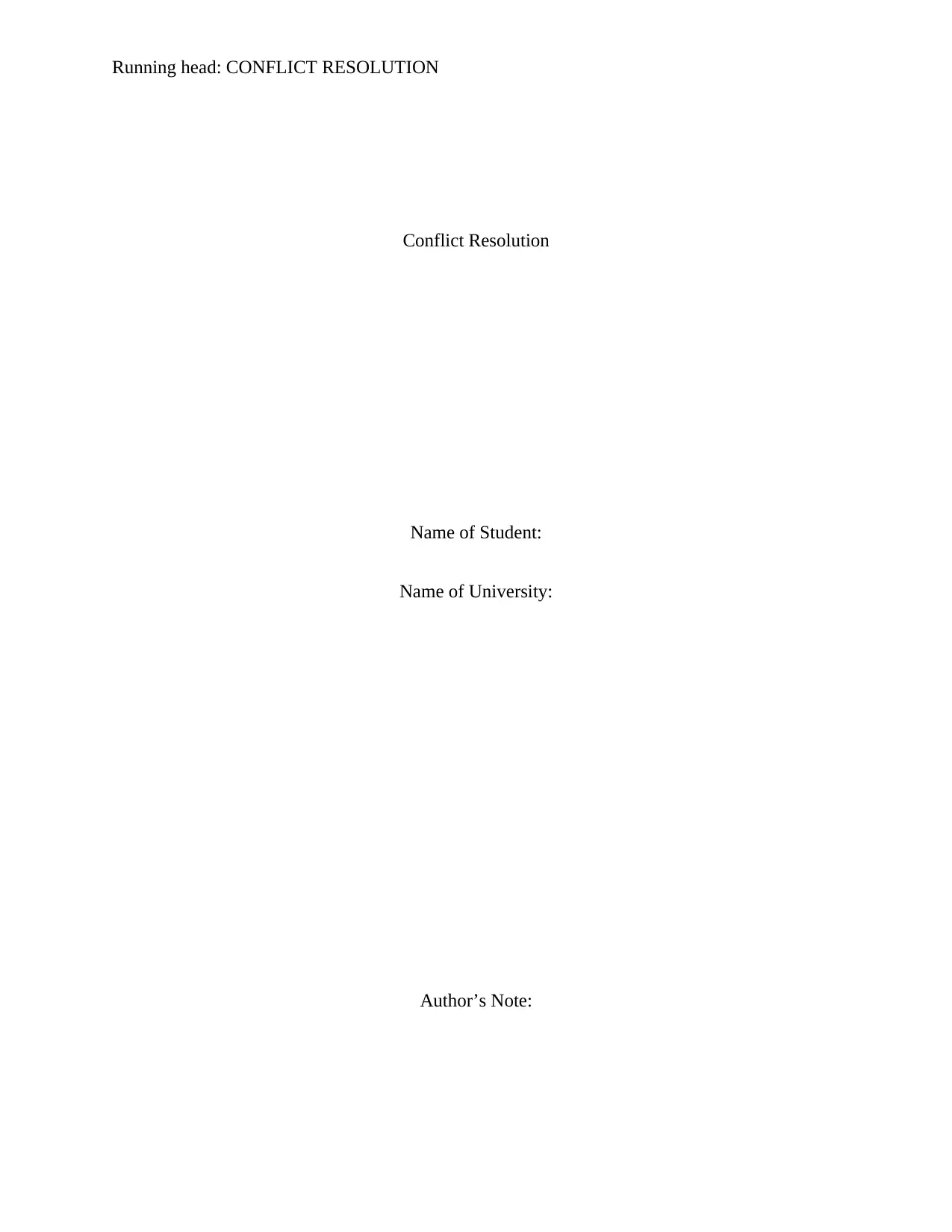
Running head: CONFLICT RESOLUTION
Conflict Resolution
Name of Student:
Name of University:
Author’s Note:
Conflict Resolution
Name of Student:
Name of University:
Author’s Note:
Paraphrase This Document
Need a fresh take? Get an instant paraphrase of this document with our AI Paraphraser
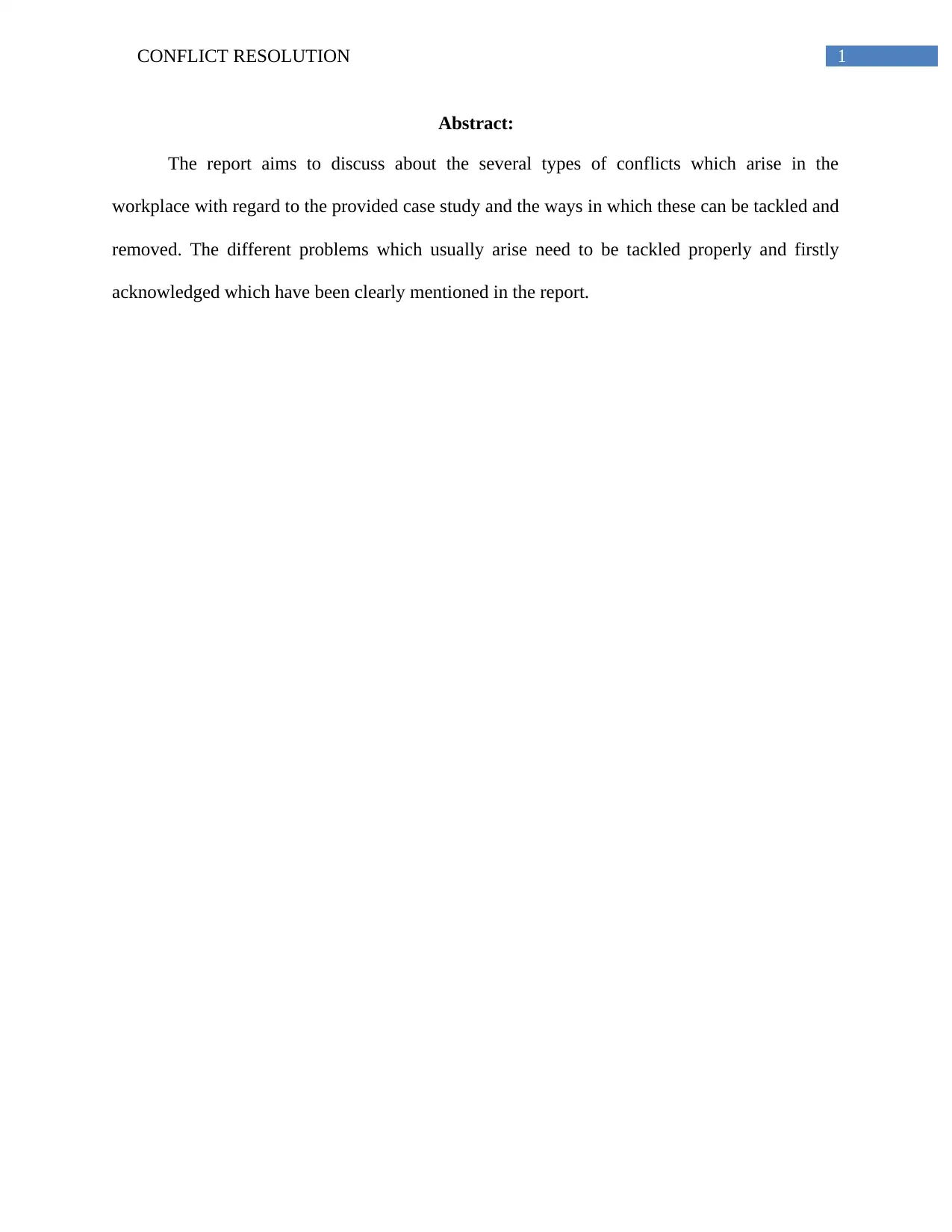
1CONFLICT RESOLUTION
Abstract:
The report aims to discuss about the several types of conflicts which arise in the
workplace with regard to the provided case study and the ways in which these can be tackled and
removed. The different problems which usually arise need to be tackled properly and firstly
acknowledged which have been clearly mentioned in the report.
Abstract:
The report aims to discuss about the several types of conflicts which arise in the
workplace with regard to the provided case study and the ways in which these can be tackled and
removed. The different problems which usually arise need to be tackled properly and firstly
acknowledged which have been clearly mentioned in the report.
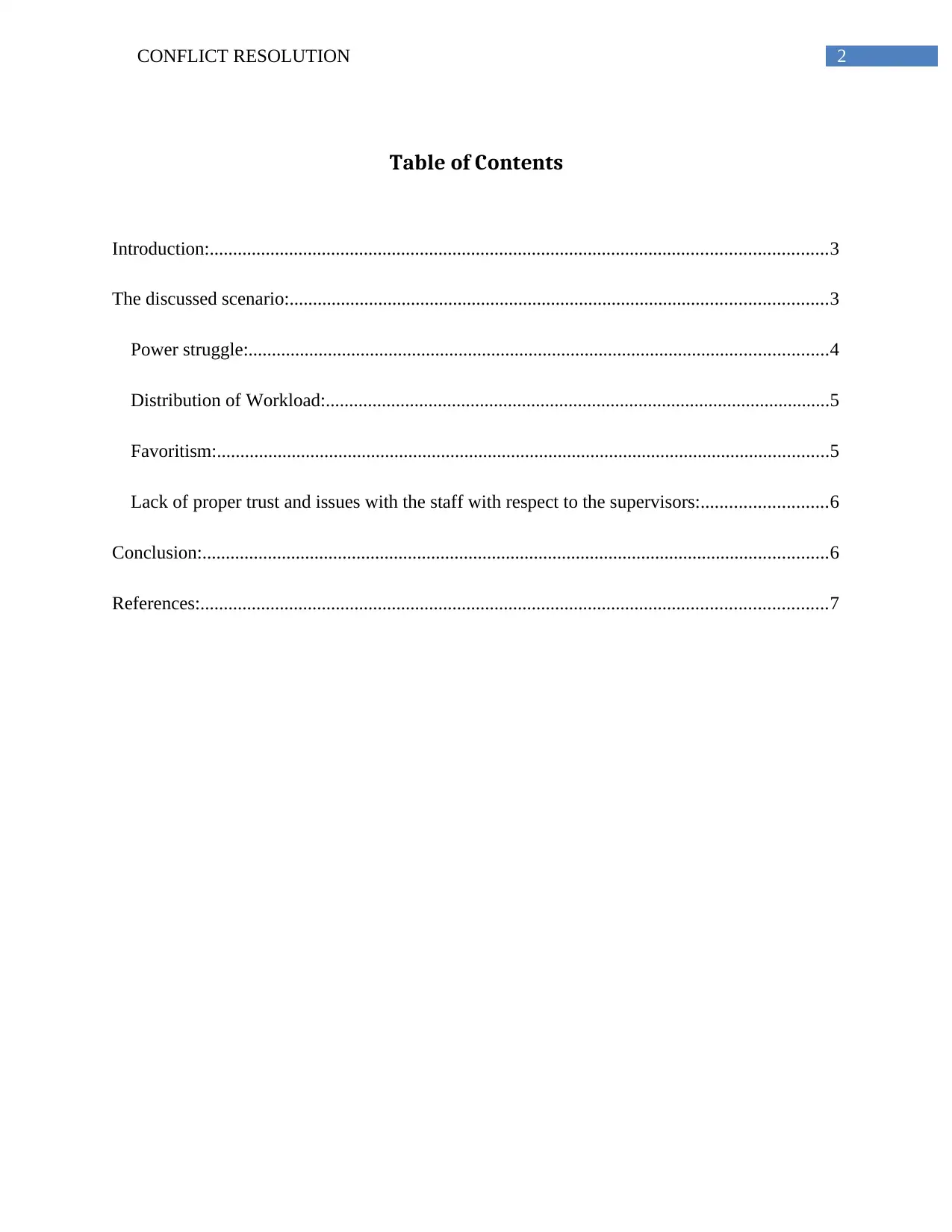
2CONFLICT RESOLUTION
Table of Contents
Introduction:....................................................................................................................................3
The discussed scenario:...................................................................................................................3
Power struggle:............................................................................................................................4
Distribution of Workload:............................................................................................................5
Favoritism:...................................................................................................................................5
Lack of proper trust and issues with the staff with respect to the supervisors:...........................6
Conclusion:......................................................................................................................................6
References:......................................................................................................................................7
Table of Contents
Introduction:....................................................................................................................................3
The discussed scenario:...................................................................................................................3
Power struggle:............................................................................................................................4
Distribution of Workload:............................................................................................................5
Favoritism:...................................................................................................................................5
Lack of proper trust and issues with the staff with respect to the supervisors:...........................6
Conclusion:......................................................................................................................................6
References:......................................................................................................................................7
⊘ This is a preview!⊘
Do you want full access?
Subscribe today to unlock all pages.

Trusted by 1+ million students worldwide
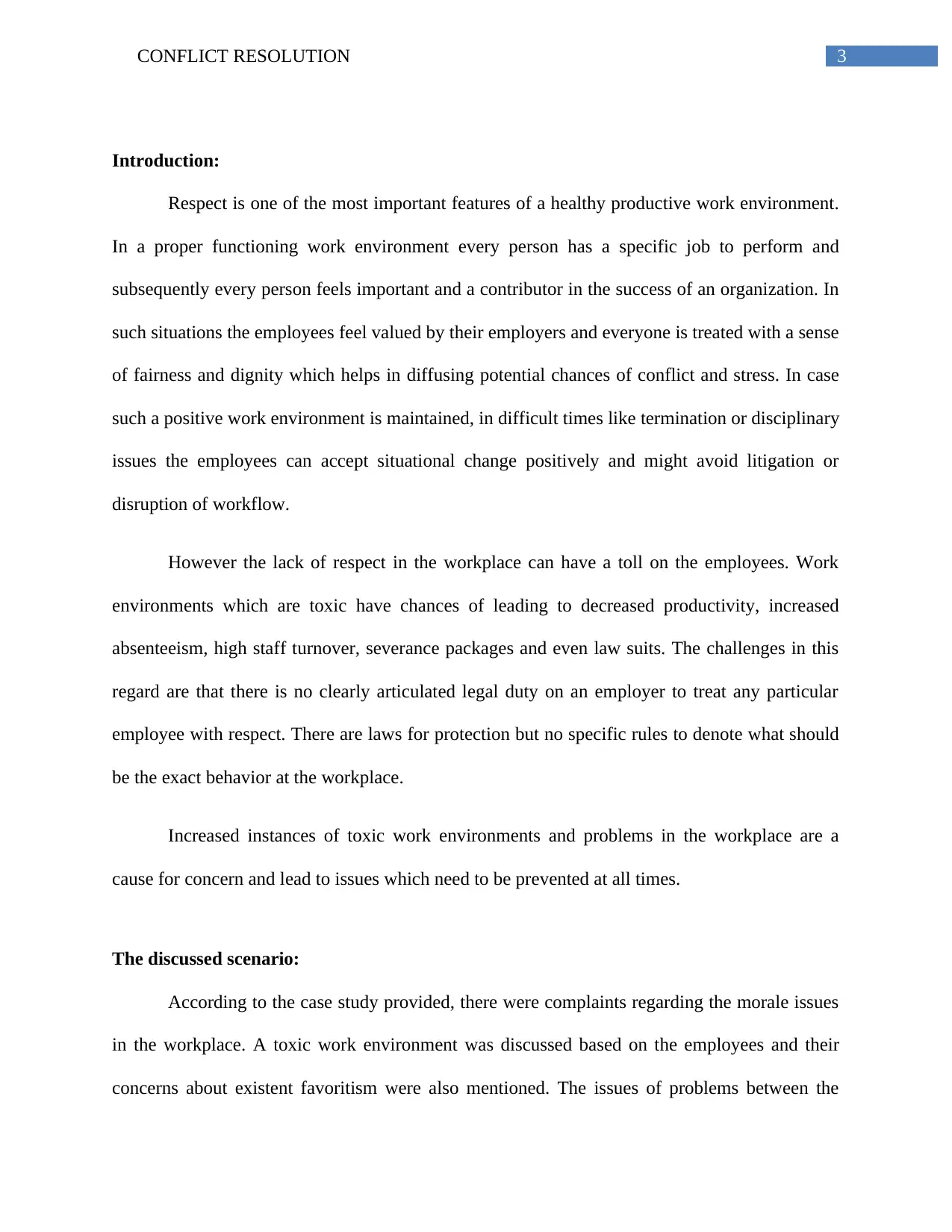
3CONFLICT RESOLUTION
Introduction:
Respect is one of the most important features of a healthy productive work environment.
In a proper functioning work environment every person has a specific job to perform and
subsequently every person feels important and a contributor in the success of an organization. In
such situations the employees feel valued by their employers and everyone is treated with a sense
of fairness and dignity which helps in diffusing potential chances of conflict and stress. In case
such a positive work environment is maintained, in difficult times like termination or disciplinary
issues the employees can accept situational change positively and might avoid litigation or
disruption of workflow.
However the lack of respect in the workplace can have a toll on the employees. Work
environments which are toxic have chances of leading to decreased productivity, increased
absenteeism, high staff turnover, severance packages and even law suits. The challenges in this
regard are that there is no clearly articulated legal duty on an employer to treat any particular
employee with respect. There are laws for protection but no specific rules to denote what should
be the exact behavior at the workplace.
Increased instances of toxic work environments and problems in the workplace are a
cause for concern and lead to issues which need to be prevented at all times.
The discussed scenario:
According to the case study provided, there were complaints regarding the morale issues
in the workplace. A toxic work environment was discussed based on the employees and their
concerns about existent favoritism were also mentioned. The issues of problems between the
Introduction:
Respect is one of the most important features of a healthy productive work environment.
In a proper functioning work environment every person has a specific job to perform and
subsequently every person feels important and a contributor in the success of an organization. In
such situations the employees feel valued by their employers and everyone is treated with a sense
of fairness and dignity which helps in diffusing potential chances of conflict and stress. In case
such a positive work environment is maintained, in difficult times like termination or disciplinary
issues the employees can accept situational change positively and might avoid litigation or
disruption of workflow.
However the lack of respect in the workplace can have a toll on the employees. Work
environments which are toxic have chances of leading to decreased productivity, increased
absenteeism, high staff turnover, severance packages and even law suits. The challenges in this
regard are that there is no clearly articulated legal duty on an employer to treat any particular
employee with respect. There are laws for protection but no specific rules to denote what should
be the exact behavior at the workplace.
Increased instances of toxic work environments and problems in the workplace are a
cause for concern and lead to issues which need to be prevented at all times.
The discussed scenario:
According to the case study provided, there were complaints regarding the morale issues
in the workplace. A toxic work environment was discussed based on the employees and their
concerns about existent favoritism were also mentioned. The issues of problems between the
Paraphrase This Document
Need a fresh take? Get an instant paraphrase of this document with our AI Paraphraser

4CONFLICT RESOLUTION
supervisor in the office and his boss were mentioned. Repeated change of staff and replacement
of inexperienced staff for experienced ones were also mentioned resulting in the increased
amount of workload and lesser productivity. The issue of favoritism was also mentioned which
had a bad impact on the employees and resulted in an increased disinterest towards their work.
All these issues contributed to the toxicity of the work environment and damaged the repute.
Thus the mentioned issues need to be resolved to maintain positivity and in order to retain the
employees.
Power struggle:
One of the most important issues which have been mentioned is that of a power struggle
between the supervisor and his boss. The issues also persisted after the boss left and a new
person came. Power struggle is a type of interpersonal conflict which might harm the company.
The interpersonal conflict is not uncommon and is because of high competition and variable
personalities of the persons that the power struggles arise (Forsyth).
In cases when such power struggles are experienced by the other subordinate employees
it is better that they step in the struggle and never take sides but try to bridge the gap. The
interruption by a third party in certain cases might lead to a thoughtful and understanding
approach by both the parties and the conflict might be resolved. No matter whatever the position
of the employee who wishes to intervene, it is imperative that he or she steps in for management
of the conflict. An appeal should be made to both the supervisor and the boss to reconsider their
differences. A combined appeal should also be made to them on behalf of all the employees in
order to resolve the conflict of the supervisor and his boss (Saundry, Richard and Wibberley).
supervisor in the office and his boss were mentioned. Repeated change of staff and replacement
of inexperienced staff for experienced ones were also mentioned resulting in the increased
amount of workload and lesser productivity. The issue of favoritism was also mentioned which
had a bad impact on the employees and resulted in an increased disinterest towards their work.
All these issues contributed to the toxicity of the work environment and damaged the repute.
Thus the mentioned issues need to be resolved to maintain positivity and in order to retain the
employees.
Power struggle:
One of the most important issues which have been mentioned is that of a power struggle
between the supervisor and his boss. The issues also persisted after the boss left and a new
person came. Power struggle is a type of interpersonal conflict which might harm the company.
The interpersonal conflict is not uncommon and is because of high competition and variable
personalities of the persons that the power struggles arise (Forsyth).
In cases when such power struggles are experienced by the other subordinate employees
it is better that they step in the struggle and never take sides but try to bridge the gap. The
interruption by a third party in certain cases might lead to a thoughtful and understanding
approach by both the parties and the conflict might be resolved. No matter whatever the position
of the employee who wishes to intervene, it is imperative that he or she steps in for management
of the conflict. An appeal should be made to both the supervisor and the boss to reconsider their
differences. A combined appeal should also be made to them on behalf of all the employees in
order to resolve the conflict of the supervisor and his boss (Saundry, Richard and Wibberley).
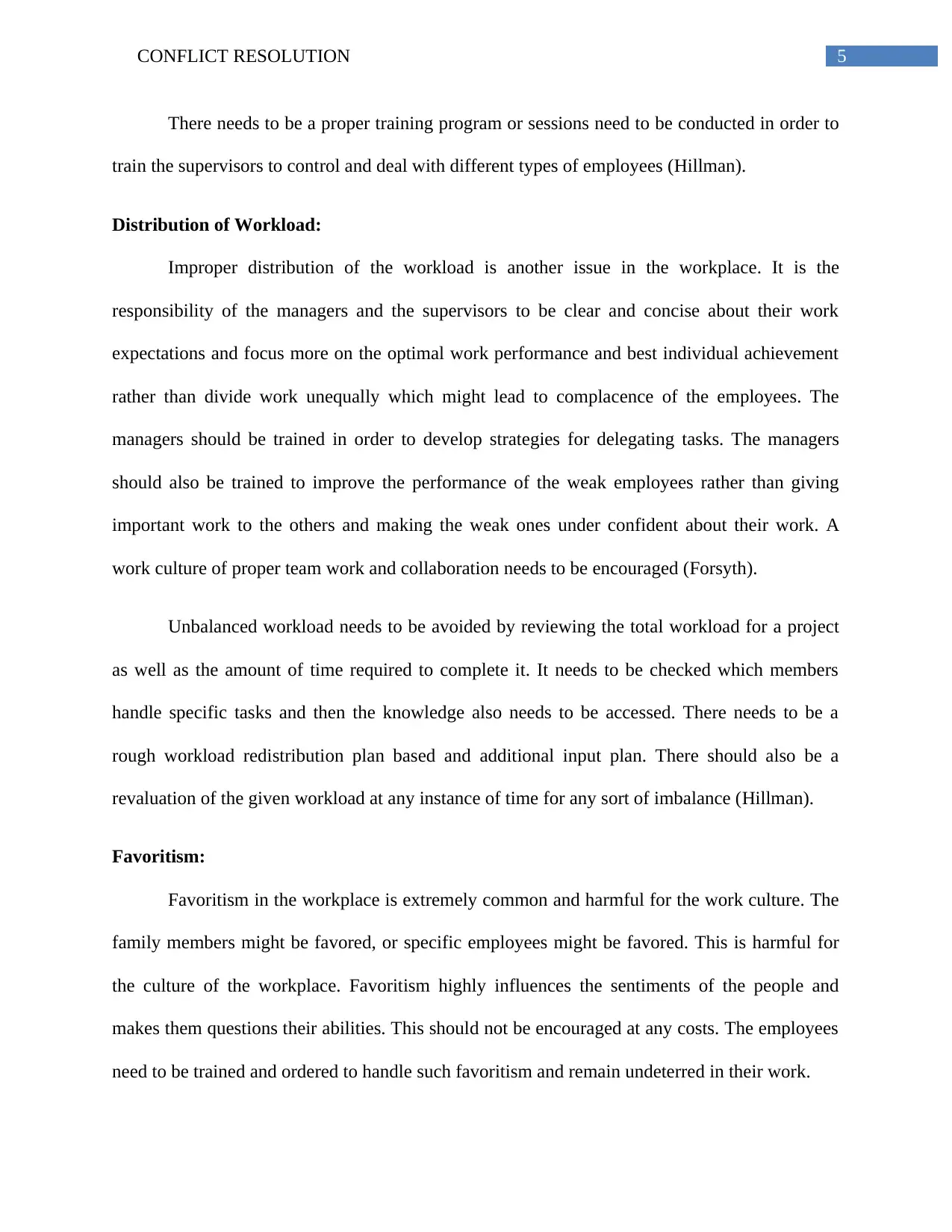
5CONFLICT RESOLUTION
There needs to be a proper training program or sessions need to be conducted in order to
train the supervisors to control and deal with different types of employees (Hillman).
Distribution of Workload:
Improper distribution of the workload is another issue in the workplace. It is the
responsibility of the managers and the supervisors to be clear and concise about their work
expectations and focus more on the optimal work performance and best individual achievement
rather than divide work unequally which might lead to complacence of the employees. The
managers should be trained in order to develop strategies for delegating tasks. The managers
should also be trained to improve the performance of the weak employees rather than giving
important work to the others and making the weak ones under confident about their work. A
work culture of proper team work and collaboration needs to be encouraged (Forsyth).
Unbalanced workload needs to be avoided by reviewing the total workload for a project
as well as the amount of time required to complete it. It needs to be checked which members
handle specific tasks and then the knowledge also needs to be accessed. There needs to be a
rough workload redistribution plan based and additional input plan. There should also be a
revaluation of the given workload at any instance of time for any sort of imbalance (Hillman).
Favoritism:
Favoritism in the workplace is extremely common and harmful for the work culture. The
family members might be favored, or specific employees might be favored. This is harmful for
the culture of the workplace. Favoritism highly influences the sentiments of the people and
makes them questions their abilities. This should not be encouraged at any costs. The employees
need to be trained and ordered to handle such favoritism and remain undeterred in their work.
There needs to be a proper training program or sessions need to be conducted in order to
train the supervisors to control and deal with different types of employees (Hillman).
Distribution of Workload:
Improper distribution of the workload is another issue in the workplace. It is the
responsibility of the managers and the supervisors to be clear and concise about their work
expectations and focus more on the optimal work performance and best individual achievement
rather than divide work unequally which might lead to complacence of the employees. The
managers should be trained in order to develop strategies for delegating tasks. The managers
should also be trained to improve the performance of the weak employees rather than giving
important work to the others and making the weak ones under confident about their work. A
work culture of proper team work and collaboration needs to be encouraged (Forsyth).
Unbalanced workload needs to be avoided by reviewing the total workload for a project
as well as the amount of time required to complete it. It needs to be checked which members
handle specific tasks and then the knowledge also needs to be accessed. There needs to be a
rough workload redistribution plan based and additional input plan. There should also be a
revaluation of the given workload at any instance of time for any sort of imbalance (Hillman).
Favoritism:
Favoritism in the workplace is extremely common and harmful for the work culture. The
family members might be favored, or specific employees might be favored. This is harmful for
the culture of the workplace. Favoritism highly influences the sentiments of the people and
makes them questions their abilities. This should not be encouraged at any costs. The employees
need to be trained and ordered to handle such favoritism and remain undeterred in their work.
⊘ This is a preview!⊘
Do you want full access?
Subscribe today to unlock all pages.

Trusted by 1+ million students worldwide
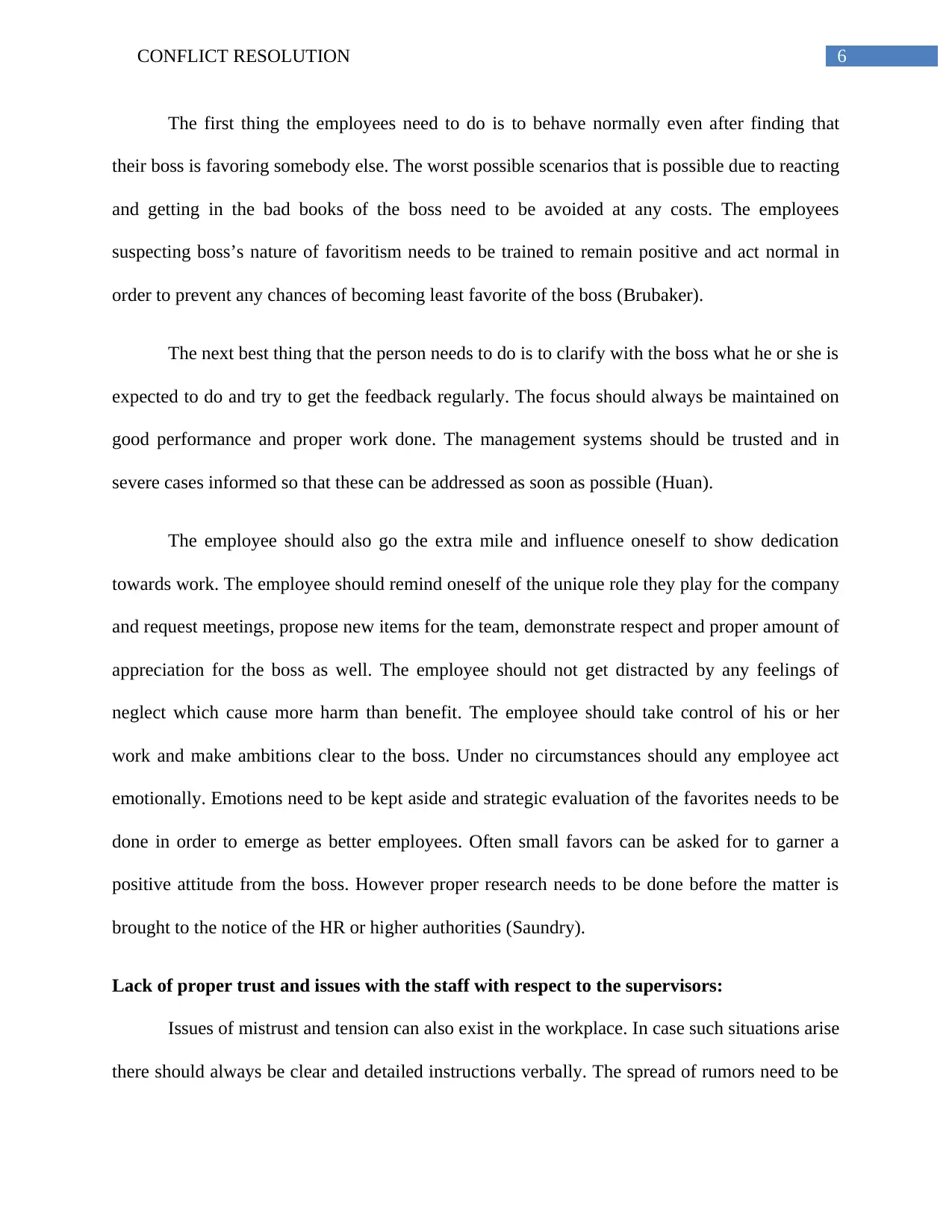
6CONFLICT RESOLUTION
The first thing the employees need to do is to behave normally even after finding that
their boss is favoring somebody else. The worst possible scenarios that is possible due to reacting
and getting in the bad books of the boss need to be avoided at any costs. The employees
suspecting boss’s nature of favoritism needs to be trained to remain positive and act normal in
order to prevent any chances of becoming least favorite of the boss (Brubaker).
The next best thing that the person needs to do is to clarify with the boss what he or she is
expected to do and try to get the feedback regularly. The focus should always be maintained on
good performance and proper work done. The management systems should be trusted and in
severe cases informed so that these can be addressed as soon as possible (Huan).
The employee should also go the extra mile and influence oneself to show dedication
towards work. The employee should remind oneself of the unique role they play for the company
and request meetings, propose new items for the team, demonstrate respect and proper amount of
appreciation for the boss as well. The employee should not get distracted by any feelings of
neglect which cause more harm than benefit. The employee should take control of his or her
work and make ambitions clear to the boss. Under no circumstances should any employee act
emotionally. Emotions need to be kept aside and strategic evaluation of the favorites needs to be
done in order to emerge as better employees. Often small favors can be asked for to garner a
positive attitude from the boss. However proper research needs to be done before the matter is
brought to the notice of the HR or higher authorities (Saundry).
Lack of proper trust and issues with the staff with respect to the supervisors:
Issues of mistrust and tension can also exist in the workplace. In case such situations arise
there should always be clear and detailed instructions verbally. The spread of rumors need to be
The first thing the employees need to do is to behave normally even after finding that
their boss is favoring somebody else. The worst possible scenarios that is possible due to reacting
and getting in the bad books of the boss need to be avoided at any costs. The employees
suspecting boss’s nature of favoritism needs to be trained to remain positive and act normal in
order to prevent any chances of becoming least favorite of the boss (Brubaker).
The next best thing that the person needs to do is to clarify with the boss what he or she is
expected to do and try to get the feedback regularly. The focus should always be maintained on
good performance and proper work done. The management systems should be trusted and in
severe cases informed so that these can be addressed as soon as possible (Huan).
The employee should also go the extra mile and influence oneself to show dedication
towards work. The employee should remind oneself of the unique role they play for the company
and request meetings, propose new items for the team, demonstrate respect and proper amount of
appreciation for the boss as well. The employee should not get distracted by any feelings of
neglect which cause more harm than benefit. The employee should take control of his or her
work and make ambitions clear to the boss. Under no circumstances should any employee act
emotionally. Emotions need to be kept aside and strategic evaluation of the favorites needs to be
done in order to emerge as better employees. Often small favors can be asked for to garner a
positive attitude from the boss. However proper research needs to be done before the matter is
brought to the notice of the HR or higher authorities (Saundry).
Lack of proper trust and issues with the staff with respect to the supervisors:
Issues of mistrust and tension can also exist in the workplace. In case such situations arise
there should always be clear and detailed instructions verbally. The spread of rumors need to be
Paraphrase This Document
Need a fresh take? Get an instant paraphrase of this document with our AI Paraphraser
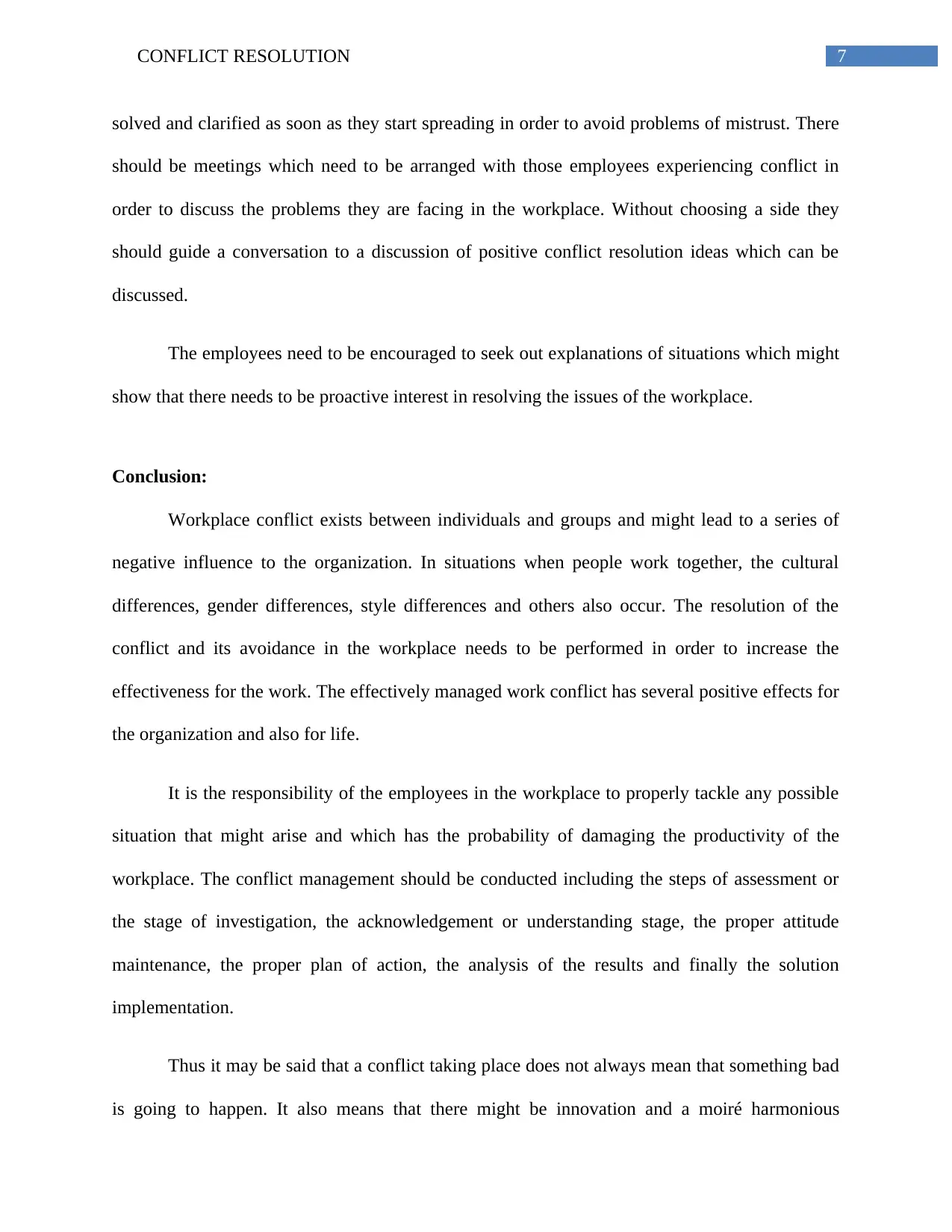
7CONFLICT RESOLUTION
solved and clarified as soon as they start spreading in order to avoid problems of mistrust. There
should be meetings which need to be arranged with those employees experiencing conflict in
order to discuss the problems they are facing in the workplace. Without choosing a side they
should guide a conversation to a discussion of positive conflict resolution ideas which can be
discussed.
The employees need to be encouraged to seek out explanations of situations which might
show that there needs to be proactive interest in resolving the issues of the workplace.
Conclusion:
Workplace conflict exists between individuals and groups and might lead to a series of
negative influence to the organization. In situations when people work together, the cultural
differences, gender differences, style differences and others also occur. The resolution of the
conflict and its avoidance in the workplace needs to be performed in order to increase the
effectiveness for the work. The effectively managed work conflict has several positive effects for
the organization and also for life.
It is the responsibility of the employees in the workplace to properly tackle any possible
situation that might arise and which has the probability of damaging the productivity of the
workplace. The conflict management should be conducted including the steps of assessment or
the stage of investigation, the acknowledgement or understanding stage, the proper attitude
maintenance, the proper plan of action, the analysis of the results and finally the solution
implementation.
Thus it may be said that a conflict taking place does not always mean that something bad
is going to happen. It also means that there might be innovation and a moiré harmonious
solved and clarified as soon as they start spreading in order to avoid problems of mistrust. There
should be meetings which need to be arranged with those employees experiencing conflict in
order to discuss the problems they are facing in the workplace. Without choosing a side they
should guide a conversation to a discussion of positive conflict resolution ideas which can be
discussed.
The employees need to be encouraged to seek out explanations of situations which might
show that there needs to be proactive interest in resolving the issues of the workplace.
Conclusion:
Workplace conflict exists between individuals and groups and might lead to a series of
negative influence to the organization. In situations when people work together, the cultural
differences, gender differences, style differences and others also occur. The resolution of the
conflict and its avoidance in the workplace needs to be performed in order to increase the
effectiveness for the work. The effectively managed work conflict has several positive effects for
the organization and also for life.
It is the responsibility of the employees in the workplace to properly tackle any possible
situation that might arise and which has the probability of damaging the productivity of the
workplace. The conflict management should be conducted including the steps of assessment or
the stage of investigation, the acknowledgement or understanding stage, the proper attitude
maintenance, the proper plan of action, the analysis of the results and finally the solution
implementation.
Thus it may be said that a conflict taking place does not always mean that something bad
is going to happen. It also means that there might be innovation and a moiré harmonious

8CONFLICT RESOLUTION
workplace. In case of a conflict in the workplace, it should not be hidden or ignored, instead it
should be faced and resolved. The improved communication skill, developed emotional
intelligence, respect towards others and the effort to work for the betterment of the organization
are all helpful towards the avoidance of any sort of conflict.
workplace. In case of a conflict in the workplace, it should not be hidden or ignored, instead it
should be faced and resolved. The improved communication skill, developed emotional
intelligence, respect towards others and the effort to work for the betterment of the organization
are all helpful towards the avoidance of any sort of conflict.
⊘ This is a preview!⊘
Do you want full access?
Subscribe today to unlock all pages.

Trusted by 1+ million students worldwide
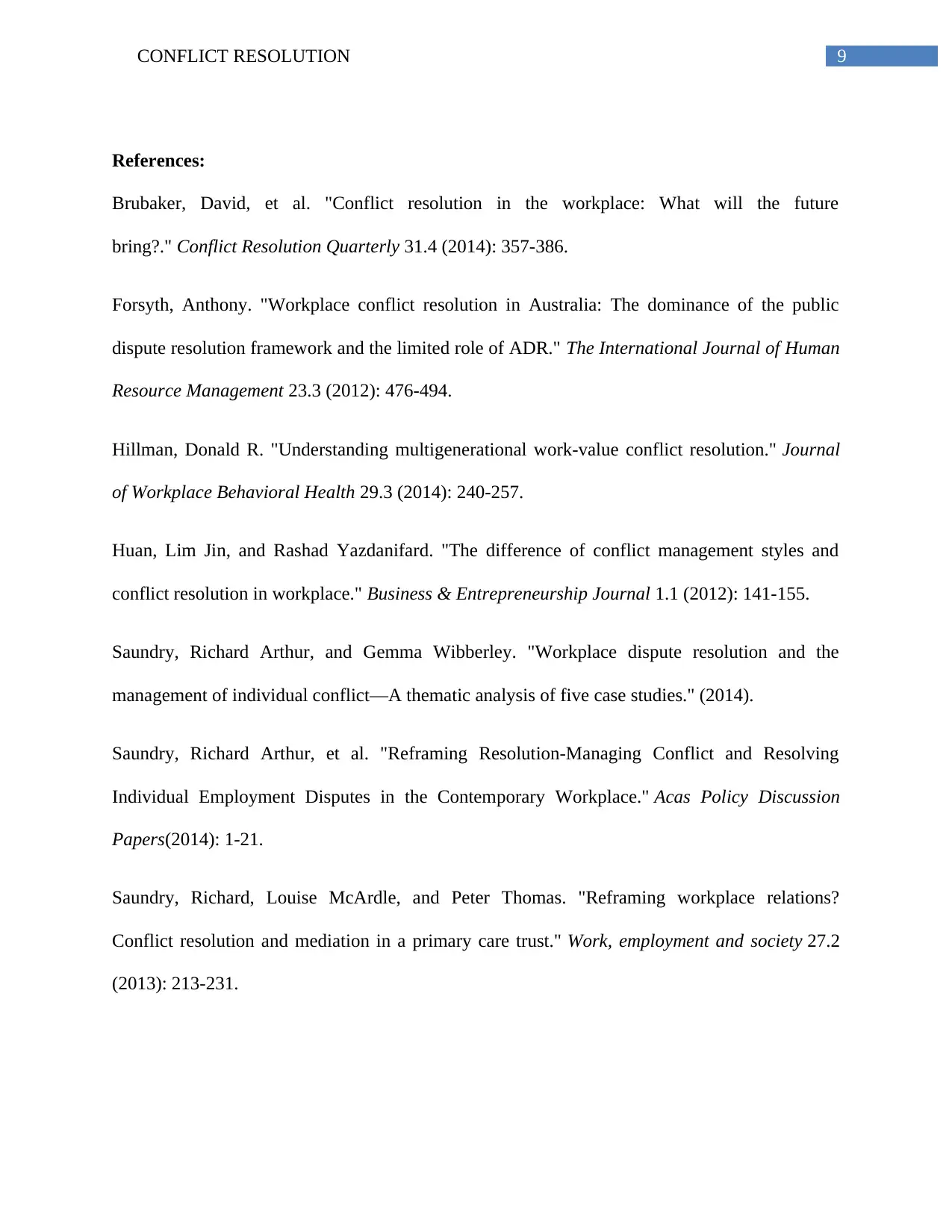
9CONFLICT RESOLUTION
References:
Brubaker, David, et al. "Conflict resolution in the workplace: What will the future
bring?." Conflict Resolution Quarterly 31.4 (2014): 357-386.
Forsyth, Anthony. "Workplace conflict resolution in Australia: The dominance of the public
dispute resolution framework and the limited role of ADR." The International Journal of Human
Resource Management 23.3 (2012): 476-494.
Hillman, Donald R. "Understanding multigenerational work-value conflict resolution." Journal
of Workplace Behavioral Health 29.3 (2014): 240-257.
Huan, Lim Jin, and Rashad Yazdanifard. "The difference of conflict management styles and
conflict resolution in workplace." Business & Entrepreneurship Journal 1.1 (2012): 141-155.
Saundry, Richard Arthur, and Gemma Wibberley. "Workplace dispute resolution and the
management of individual conflict—A thematic analysis of five case studies." (2014).
Saundry, Richard Arthur, et al. "Reframing Resolution-Managing Conflict and Resolving
Individual Employment Disputes in the Contemporary Workplace." Acas Policy Discussion
Papers(2014): 1-21.
Saundry, Richard, Louise McArdle, and Peter Thomas. "Reframing workplace relations?
Conflict resolution and mediation in a primary care trust." Work, employment and society 27.2
(2013): 213-231.
References:
Brubaker, David, et al. "Conflict resolution in the workplace: What will the future
bring?." Conflict Resolution Quarterly 31.4 (2014): 357-386.
Forsyth, Anthony. "Workplace conflict resolution in Australia: The dominance of the public
dispute resolution framework and the limited role of ADR." The International Journal of Human
Resource Management 23.3 (2012): 476-494.
Hillman, Donald R. "Understanding multigenerational work-value conflict resolution." Journal
of Workplace Behavioral Health 29.3 (2014): 240-257.
Huan, Lim Jin, and Rashad Yazdanifard. "The difference of conflict management styles and
conflict resolution in workplace." Business & Entrepreneurship Journal 1.1 (2012): 141-155.
Saundry, Richard Arthur, and Gemma Wibberley. "Workplace dispute resolution and the
management of individual conflict—A thematic analysis of five case studies." (2014).
Saundry, Richard Arthur, et al. "Reframing Resolution-Managing Conflict and Resolving
Individual Employment Disputes in the Contemporary Workplace." Acas Policy Discussion
Papers(2014): 1-21.
Saundry, Richard, Louise McArdle, and Peter Thomas. "Reframing workplace relations?
Conflict resolution and mediation in a primary care trust." Work, employment and society 27.2
(2013): 213-231.
1 out of 10
Related Documents
Your All-in-One AI-Powered Toolkit for Academic Success.
+13062052269
info@desklib.com
Available 24*7 on WhatsApp / Email
![[object Object]](/_next/static/media/star-bottom.7253800d.svg)
Unlock your academic potential
Copyright © 2020–2025 A2Z Services. All Rights Reserved. Developed and managed by ZUCOL.





